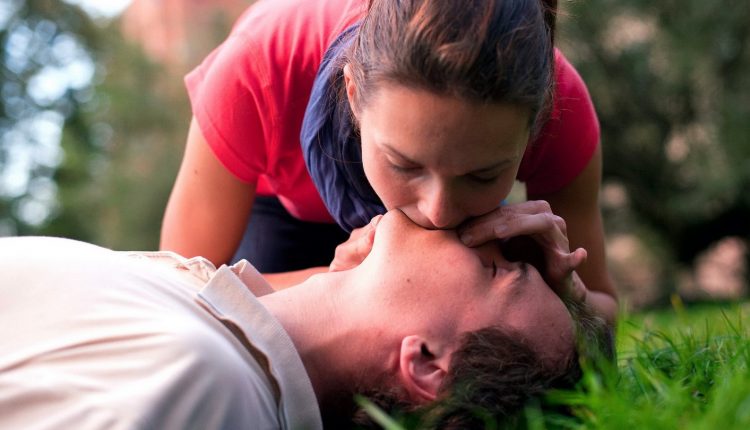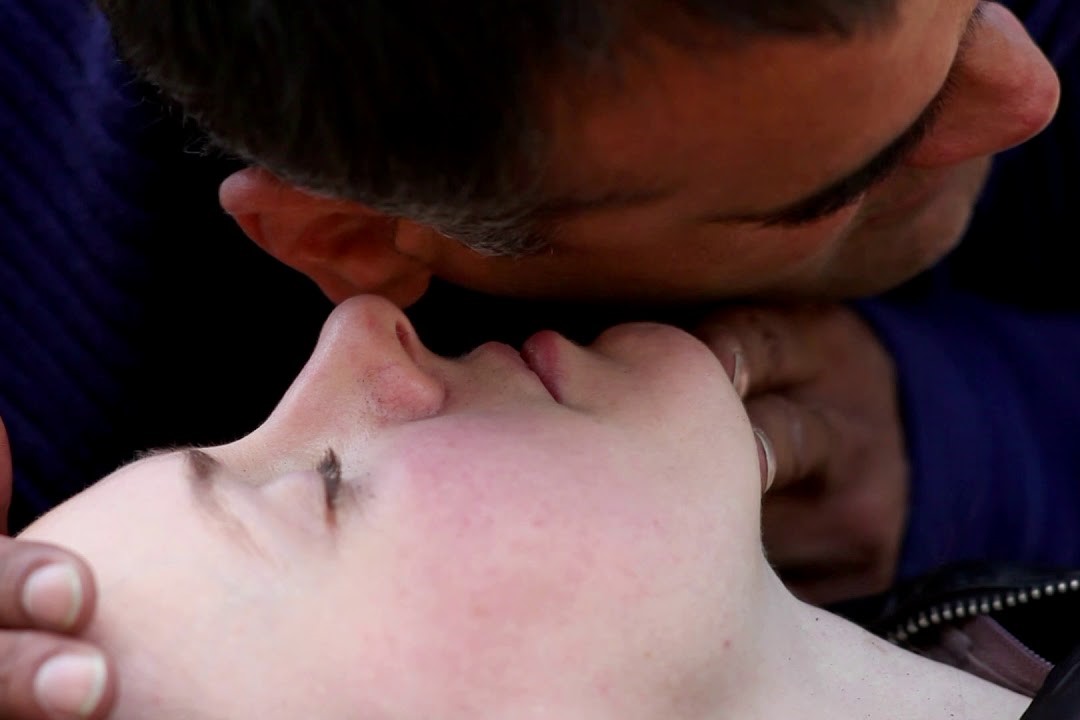
ການຟື້ນຄືນຊີວິດຈາກປາກຕໍ່ປາກ: ເມື່ອໃດທີ່ຈະເຮັດມັນແລະວິທີການເຮັດມັນ
Mouth-to-mouth resuscitation is a medical technique that is part of the artificial respiration techniques that, together with other methods, enables BLS, which stands for ‘Basic Life Support’ (basic support for vital functions), i.e. a set of actions that enable first aid to be given to individuals who have suffered a trauma, e.g. car accident, cardiac arrest or electrocution
BLS includes several components:
- ການປະເມີນຂອງ scene ໄດ້
- assessment of the subject’s state of consciousness;
- call for help by telephone;
- ABC (ການປະເມີນຜົນຂອງ patency ຂອງເສັ້ນທາງຫາຍໃຈ, ການມີຂອງການຫາຍໃຈແລະກິດຈະກໍາຂອງຫົວໃຈ);
- cardiopulmonary resuscitation (CPR): consisting of cardiac massage and mouth-to-mouth breathing;
- ອື່ນໆ ສະຫນັບສະຫນູນຊີວິດພື້ນຖານ ການກະ ທຳ.
Assessing the state of consciousness
In emergency situations, the first thing to do – after assessing that the area poses no further risk to the operator or the casualty – is to assess the subject’s state of consciousness:
- stand close to the body;
- the person should be shaken very lightly by the shoulders (to avoid further injury);
- the person must be called out loud (remembering that the person, if unknown, may be deaf);
- if the person does not react, then he/she is defined as unconscious: in this case, no time should be wasted and an immediate request should be made to those close by to call the medical emergency telephone number 118 and/or 112;
ໃນເວລານີ້, ເລີ່ມຕົ້ນ ABCs, ເຊັ່ນ:
- check whether the airway is clear of objects obstructing breathing;
- checks whether breathing is present;
- check whether cardiac activity is present via carotid (ຄໍ) ຫຼື radial (ກໍາມະຈອນ) ກໍາມະຈອນ;
- in the absence of breathing and cardiac activity, initiate cardiopulmonary resuscitation (CPR) manoeuvres.
If available, use an automatic/semi-automatic defibrillator, capable of assessing the cardiac alteration and the possibility of delivering the electrical impulse to perform cardioversion (return to a sinus rhythm, i.e. normal).
On the other hand, do not use a manual defibrillator if you are not a doctor: it could make the situation worse.
ການຝຶກອົບຮົມ: ໄປຢ້ຽມຢາມບູດຂອງ DMC DINAS ທີ່ປຶກສາດ້ານການແພດໃນງານວາງສະແດງສຸກເສີນ
Mouth-to-mouth breathing
For every 30 compressions of cardiac massage, it is necessary to give 2 insufflations with artificial respiration (ratio 30:2).
Mouth-to-mouth respiration consists of these steps:
- Lay the casualty in a supine position (belly up).
- The casualty’s head is rotated backwards.
- Check the airway and remove any foreign bodies from the oral cavity.
If trauma is NOT suspected, lift the jaw of the casualty by bending the head backwards: this prevents the casualty’s tongue from blocking the airway.
If ກະດູກສັນຫລັງ trauma is suspected, do not make any reckless movements: they may make the situation worse.
ປິດຮູດັງຂອງຜູ້ເຄາະຮ້າຍດ້ວຍໂປ້ໂປ້ ແລະ ນິ້ວໂປ້ຂອງເຈົ້າ. ຂໍ້ຄວນລະວັງ: ການລືມປິດດັງຈະເຮັດໃຫ້ການຜ່າຕັດທັງໝົດບໍ່ມີປະສິດທິພາບ!
Inhale normally and insufflate air through the mouth (or if this is not possible, through the nose) of the casualty, checking that the rib cage is raised.
ເຮັດຊ້ຳໃນອັດຕາ 15-20 ຫາຍໃຈຕໍ່ນາທີ (ໜຶ່ງລົມຫາຍໃຈທຸກໆ 3 ຫາ 4 ວິນາທີ).
It is essential that the head remains hyperextended during mouth-to-mouth insufflations.
An incorrect airway position exposes the victim to the risk of air entering the stomach, thus easily causing regurgitation.
The latter is also caused by the power with which one blows: blowing too hard sends air into the stomach.
Mouth-to-mouth respiration involves the forced insufflation of air into the casualty’s respiratory system, with the help of a mask or mouthpiece.
In the likely absence of a mask or mouthpiece, a filter barrier consisting of a light cotton handkerchief can be used to protect the rescuer from direct contact with the casualty’s mouth, especially if the latter has bleeding wounds.
The new guidelines of 2010 warn the rescuer of the risks of hyperventilation: excessive increase in intrathoracic pressure, risk of insufflation of air into the stomach, reduced venous return to the heart; for this reason, insufflations should not be excessively vigorous, but should emit an amount of air no greater than 500-600 cm³ (half a litre, in a time not exceeding one second).
The air inhaled by the rescuer before insufflation should be as ‘pure’ as possible, i.e. it should contain as high a percentage of oxygen as possible: for this reason, the rescuer should raise his or her head between insufflations to inhale at a sufficient distance so that he or she does not inhale the air emitted by the victim, which has a lower oxygen density, or his or her own (rich in carbon dioxide).
Resuscitation must always begin with compressions except in the case of trauma or if the victim is a child: in these cases we start with 5 insufflations, and continue normally with alternating compressions-insufflations.
This is because, in the case of trauma, it is assumed that there is not enough oxygen in the victim’s lungs to ensure efficient blood circulation; all the more reason, as a precautionary measure, to start with insufflations if the victim is a child, since it is presumed that a child, enjoying good health, is in a state of cardiac arrest due to causes more likely to be caused by trauma or a foreign body that has entered the airways.
In the event of a simultaneous lack of heartbeat, after every 30 compressions of cardiac massage, the caregiver – if alone – will interrupt the massage to give 2 insufflations with artificial respiration (mouth-to-mouth or with a mask or mouthpiece).
ໃນຕອນທ້າຍຂອງການ insufflation ທີສອງ, ທັນທີທັນໃດສືບຕໍ່ການນວດຫົວໃຈ.
The ratio of cardiac compressions to insufflations – in the case of a single operator – is therefore 30:2.
ຖ້າມີສອງຕົວປະຕິບັດການ, ການຫາຍໃຈທຽມສາມາດປະຕິບັດໄດ້ໃນເວລາດຽວກັນກັບການນວດຫົວໃຈ.
When not resuscitating?
Non-medical rescuers (those who are usually on the ambulances) can only ascertain death, and thus not initiate manoeuvres, only
- in the case of externally visible, decerebrate brain matter (in the case of trauma, for example);
- in the case of decapitation ;
- in the case of injuries totally incompatible with life ;
- in the case of a charred subject
- ໃນກໍລະນີຂອງວິຊາທີ່ຢູ່ໃນ mortis ເຄັ່ງຄັດ.
New changes in the A.H.A. manuals on mouth-to-mouth respiration
The most recent changes (as can be verified in the A.H.A. manuals) concern order rather than procedures.
Firstly, the emphasis on early cardiac massage, which is considered more important than early oxygenation, has increased.
ດັ່ງນັ້ນ, ລໍາດັບດັ່ງກ່າວໄດ້ປ່ຽນຈາກ ABC (ເສັ້ນທາງຫາຍໃຈເປີດ, ການຫາຍໃຈແລະການໄຫຼວຽນ) ໄປ CAB (ການໄຫຼວຽນ, ທໍ່ຫາຍໃຈເປີດແລະການຫາຍໃຈ):
- one starts with the 30 chest compressions (which must begin within 10 seconds of recognition of the heart block);
- you proceed to the airway opening manoeuvres and then to ventilation.
ນີ້ພຽງແຕ່ຊັກຊ້າການລະບາຍອາກາດຄັ້ງທໍາອິດປະມານ 20 ວິນາທີ, ເຊິ່ງບໍ່ມີຜົນກະທົບທາງລົບຕໍ່ຄວາມສໍາເລັດຂອງ CPR.
In addition, the GAS phase has been eliminated (in the victim’s assessment) because agonised breathing (gasping) may be present, which is felt by the rescuer both as a sensation of breath on the skin (Sento) and audibly (Ascolto) but which does not result in effective lung ventilation because it is spasmodic, shallow and very low frequency.
Minor changes concern the frequency of chest compressions (from about 100/min to at least 100/min) and the use of cricoid pressure to prevent gastric insufflation: cricoid pressure should be avoided as it is not effective and can prove harmful by making the insertion of advanced respiratory devices such as endotracheal tubes etc. more difficult.
ຕໍາແໜ່ງຄວາມປອດໄພທາງຂ້າງ
If breathing returns, but the patient is still unconscious and no trauma is assumed, the patient should be placed in the lateral safety position.
This is done by bending one knee and bringing the foot of the same leg under the knee of the opposite leg.
The arm opposite the flexed leg must be slid across the ground until it is perpendicular to the torso.
The other arm should be placed on the chest, so that the hand passes over the side of the neck.
Next, the rescuer should stand on the side that does not have the arm extended outwards, put his or her arm between the arch formed by the patient’s legs, and with the other grasp the head.
Using their knees, gently roll the patient onto the side of the outer arm, accompanying the movement of the head.
The head should then be hyperextended and held in this position by placing the hand of the arm that is not touching the ground under the cheek.
The purpose of this position is to keep the airway clear and prevent sudden jets of ຮາກ from occluding the respiratory cavity and entering the lungs, damaging their integrity.
With the lateral safety position, any fluid emitted is expelled out of the body.
ວິທະຍຸຄົນງານກູ້ໄພໃນໂລກ? ຢ້ຽມຊົມບູດວິທະຍຸ EMS ຢູ່ທີ່ EXPO ສຸກເສີນ
First aid in children and infants: the differences in mouth-to-mouth and paediatric BLS
The method for BLS in children aged 12 months to 8 years is similar to that used for adults.
ຢ່າງໃດກໍ່ຕາມ, ມີຄວາມແຕກຕ່າງກັນ, ເຊິ່ງຄໍານຶງເຖິງຄວາມອາດສາມາດຂອງປອດຕ່ໍາຂອງເດັກນ້ອຍແລະອັດຕາການຫາຍໃຈໄວຂອງພວກເຂົາ.
In addition, it must be remembered that compressions must be less deep than in adults.
One starts with 5 insufflations, before proceeding to cardiac massage, which has a ratio of compressions to insufflations of 15:2.
ອີງຕາມການ corpulence ຂອງເດັກ, ການບີບອັດສາມາດປະຕິບັດໄດ້ດ້ວຍແຂນຂາທັງສອງ (ໃນຜູ້ໃຫຍ່), ແຂນຂາດຽວ (ໃນເດັກນ້ອຍ), ຫຼືແມ້ກະທັ້ງພຽງແຕ່ສອງນິ້ວມື (ນິ້ວຊີ້ແລະນິ້ວກາງໃນລະດັບຂອງຂະບວນການ xiphoid ໃນເດັກນ້ອຍ).
Lastly, it should be remembered that, since the normal heart rate in children is higher than in adults, in the presence of a child presenting circulatory activity with a heart rate below 60 pulses/min, one should act as in the case of cardiac arrest.
ອ່ານຍັງ:
ມີຊີວິດສຸກເສີນຫຼາຍຂຶ້ນ…ສົດ: ດາວໂຫລດແອັບຟຣີໃໝ່ຂອງໜັງສືພິມຂອງເຈົ້າສຳລັບ IOS ແລະ Android
ການຊົດເຊີຍ, Decompensated ແລະ irreversible Shock: ສິ່ງທີ່ເຂົາເຈົ້າເປັນແລະສິ່ງທີ່ເຂົາເຈົ້າກໍານົດ
ການຟື້ນຟູການຈົມນ້ໍາສໍາລັບ Surfers
ການຊ່ວຍເຫຼືອຄັ້ງທໍາອິດ: ເວລາແລະວິທີການປະຕິບັດ Heimlich Maneuver / VIDEO
ການຊ່ວຍເຫຼືອຄັ້ງທໍາອິດ, ຫ້າຄວາມຢ້ານກົວຂອງການຕອບສະຫນອງ CPR
ປະຕິບັດການປະຖົມພະຍາບານໃນເດັກນ້ອຍ: ຄວາມແຕກຕ່າງກັບຜູ້ໃຫຍ່ແມ່ນຫຍັງ?
Heimlich Maneuver: ຊອກຫາວ່າມັນແມ່ນຫຍັງແລະເຮັດແນວໃດມັນ
Chest Trauma: ລັກສະນະທາງຄລີນິກ, ການປິ່ນປົວ, ການຊ່ວຍທາງເດີນຫາຍໃຈ ແລະລະບົບຫາຍໃຈ
ເລືອດອອກພາຍໃນ: ຄໍານິຍາມ, ສາເຫດ, ອາການ, ການບົ່ງມະຕິ, ຄວາມຮຸນແຮງ, ການປິ່ນປົວ
ຄວາມແຕກຕ່າງລະຫວ່າງ AMBU Balloon ແລະ Breathing Ball Emergency: ຂໍ້ດີແລະຂໍ້ເສຍຂອງສອງອຸປະກອນທີ່ສໍາຄັນ
ວິທີການປະຕິບັດການສໍາຫຼວດເບື້ອງຕົ້ນໂດຍໃຊ້ DRABC ໃນການປະຖົມພະຍາບານ
Heimlich Maneuver: ຊອກຫາວ່າມັນແມ່ນຫຍັງແລະເຮັດແນວໃດມັນ
ສິ່ງທີ່ຄວນຢູ່ໃນຊຸດປະຖົມພະຍາບານເດັກ
ພິດເຫັດພິດ: ຈະເຮັດແນວໃດ? ການເປັນພິດສະແດງອອກແນວໃດ?
ການເປັນພິດຂອງສານຕະກົ່ວແມ່ນຫຍັງ?
ພິດໄຮໂດຄາບອນ: ອາການ, ການວິນິດໄສ ແລະການປິ່ນປົວ
ການປະຖົມພະຍາບານເບື້ອງຕົ້ນ: ສິ່ງທີ່ຄວນເຮັດຫຼັງຈາກກືນກິນຫຼືການຮົ່ວໄຫຼຂອງສານຟອກຂາວໃສ່ຜິວຫນັງຂອງທ່ານ
ອາການແລະອາການຂອງອາການຊ໊ອກ: ວິທີການແລະເວລາທີ່ຈະແຊກແຊງ
Wasp Sting ແລະອາການຊ໊ອກ Anaphylactic: ສິ່ງທີ່ຕ້ອງເຮັດກ່ອນທີ່ລົດສຸກເສີນມາຮອດ?
ຊ໊ອກກະດູກສັນຫຼັງ: ສາເຫດ, ອາການ, ຄວາມສ່ຽງ, ການວິນິດໄສ, ການປິ່ນປົວ, ການຄາດຄະເນ, ການເສຍຊີວິດ
Cervical Collar In Trauma ຄົນເຈັບໃນຢາສຸກເສີນ: ເມື່ອໃຊ້ມັນ, ເປັນຫຍັງມັນຈຶ່ງສໍາຄັນ
KED Extrication ອຸປະກອນສໍາລັບການສະກັດບາດແຜ: ມັນແມ່ນຫຍັງແລະວິທີການນໍາໃຊ້ມັນ
ການແນະນໍາການຝຶກອົບຮົມການປະຖົມພະຍາບານແບບພິເສດ
ການຟື້ນຟູການຈົມນ້ໍາສໍາລັບ Surfers
ຄູ່ມືດ່ວນແລະເປື້ອນສໍາລັບອາການຊ໊ອກ: ຄວາມແຕກຕ່າງລະຫວ່າງການຊົດເຊີຍ, ປະຕິເສດແລະບໍ່ສາມາດປ່ຽນແປງໄດ້
Dry and Secondary Drowning: ຄວາມໝາຍ, ອາການ ແລະການປ້ອງກັນ
ການຊ່ວຍເຫຼືອຄັ້ງທໍາອິດ: ຄໍານິຍາມ, ຄວາມຫມາຍ, ສັນຍາລັກ, ຈຸດປະສົງ, ອະນຸສັນຍາສາກົນ




